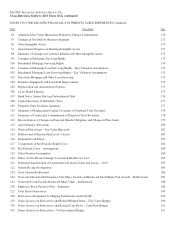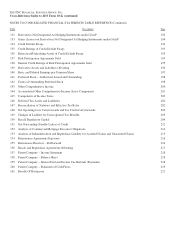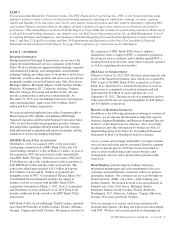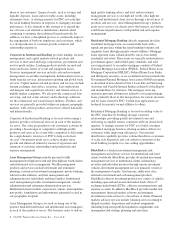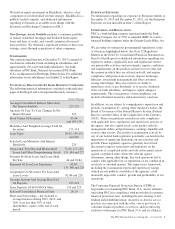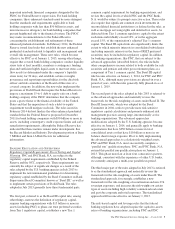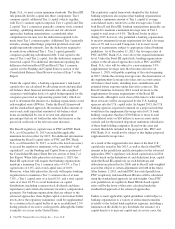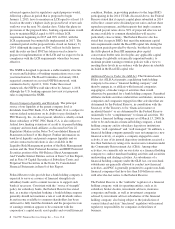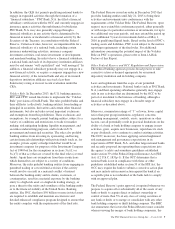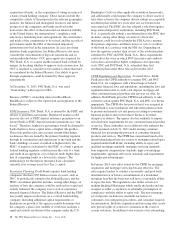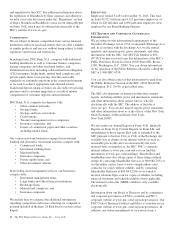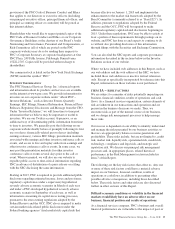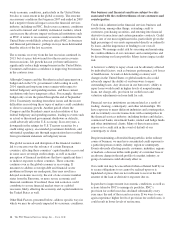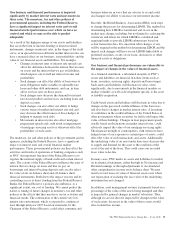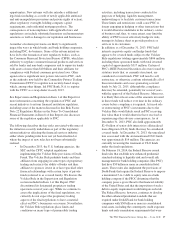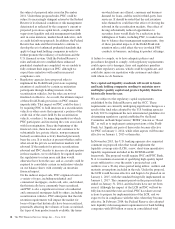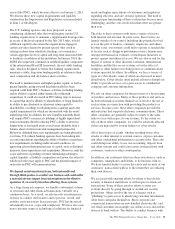PNC Bank 2013 Annual Report Download - page 27
Download and view the complete annual report
Please find page 27 of the 2013 PNC Bank annual report below. You can navigate through the pages in the report by either clicking on the pages listed below, or by using the keyword search tool below to find specific information within the annual report.
In addition, the GLB Act permits qualifying national banks to
engage in expanded activities through the formation of a
“financial subsidiary.” PNC Bank, N.A. has filed a financial
subsidiary certification with the OCC and currently engages in
insurance agency activities through financial subsidiaries.
PNC Bank, N.A. may also generally engage through a
financial subsidiary in any activity that is determined to be
financial in nature or incidental to a financial activity by the
Secretary of the Treasury, in consultation with the Federal
Reserve. Certain activities, however, are impermissible for a
financial subsidiary of a national bank, including certain
insurance underwriting activities, insurance company
investment activities, real estate investment or development,
and merchant banking. In order to have a financial subsidiary,
a national bank and each of its depository institution affiliates
must be and remain “well capitalized” and “well managed.” In
addition, a financial subsidiary generally may not engage in a
new financial activity, or acquire a company engaged in a new
financial activity, if the national bank and any of its insured
depository institution affiliates received a less than
Satisfactory rating at its most recent evaluation under the
CRA.
Volcker Rule. In December 2013, the U.S. banking agencies,
SEC and CFTC issued final rules to implement the “Volcker
Rule” provisions of Dodd-Frank. The rules prohibit banks and
their affiliates (collectively, banking entities) from trading as
principal in securities, derivatives and certain other financial
instruments, but also includes several important exclusions
and exemptions from this prohibition. These exclusions and
exemptions, for example, permit banking entities, subject to a
variety of conditions and restrictions, to trade for market
making, risk mitigating hedging, liquidity management, and
securities underwriting purposes, and to trade in U.S.
government and municipal securities. The rules also prohibit
banking entities from investing in, sponsoring, and having
certain financial relationships with private funds (such as, for
example, private equity or hedge funds that would be an
investment company for purposes of the Investment Company
Act of 1940 but for the exemptions in sections 3(c)(1) or
3(c)(7) of that act) that are covered by the final rules (covered
funds). Again there are exemptions from these restrictions
which themselves are subject to a variety of conditions.
Moreover, the rules prohibit banking entities from engaging in
permitted trading or covered fund activities if the activity
would involve or result in a material conflict of interest
between the banking entity and its clients, customers, or
counterparties, result in a material exposure by the banking
entity to a high-risk asset or a high-risk trading strategy, or
pose a threat to the safety and soundness of the banking entity
or to the financial stability of the United States. Banking
entities, like PNC, that have $50 billion or more in total assets
are required to establish and maintain an extensive and
detailed enhanced compliance program designed to ensure that
the entity complies with the requirements of the final rule.
The Federal Reserve issued an order in December 2013 that
provides banking entities until July 21, 2015 to bring their
activities and investments into conformance with the
requirements of the Volcker Rule. The Federal Reserve, upon
request, may extend this conformance period, either generally
or with respect to particular activities or investments, for up to
two additional one-year periods, and may extend the period up
to an additional 5 years for investments held as of May 1,
2010 in qualifying illiquid funds. Based on the level of PNC’s
trading assets and liabilities, PNC is not subject to the metrics
reporting requirements of the final rules. For additional
information concerning the potential impact of the Volcker
Rule on PNC’s operations, please refer to Item 1A Risk
Factors of this Report.
Other Federal Reserve and OCC Regulation and Supervision.
The federal banking agencies possess broad powers to take
corrective action as deemed appropriate for an insured
depository institution and its holding company.
Laws and regulations limit the scope of our permitted
activities and investments. National banks (such as PNC Bank,
N.A.) and their operating subsidiaries generally may engage
only in any activities that are determined by the OCC to be
part of or incidental to the business of banking, although a
financial subsidiary may engage in a broader range of
activities as described above.
Moreover, examination ratings of “3” or lower, lower capital
ratios than peer group institutions, regulatory concerns
regarding management, controls, assets, operations or other
factors, can all potentially result in practical limitations on the
ability of a bank or bank holding company to engage in new
activities, grow, acquire new businesses, repurchase its stock
or pay dividends, or to continue to conduct existing activities.
The OCC, moreover, has been applying certain heightened
risk management and governance expectations in its
supervision of PNC Bank, N.A. and other large national banks
and recently proposed incorporating these expectations into
the agency’s safety and soundness guidelines established
under section 39 of the Federal Deposit Insurance Act (FDI
Act) (12 U.S.C. 1831p-1). If the OCC determines that a
national bank is not in compliance with these or other
guidelines established under section 39 of the FDI Act, the
OCC may require the bank to submit a corrective action plan
and may initiate enforcement action against the bank if an
acceptable plan is not submitted or the bank fails to comply
with an approved plan.
The Federal Reserve’s prior approval is required whenever we
propose to acquire all or substantially all of the assets of any
bank or thrift, to acquire direct or indirect ownership or
control of more than 5% of any class of voting securities of
any bank or thrift, or to merge or consolidate with any other
bank holding company or thrift holding company. The BHC
Act enumerates the factors the Federal Reserve must consider
when reviewing the merger of bank holding companies, the
The PNC Financial Services Group, Inc. – Form 10-K 9


